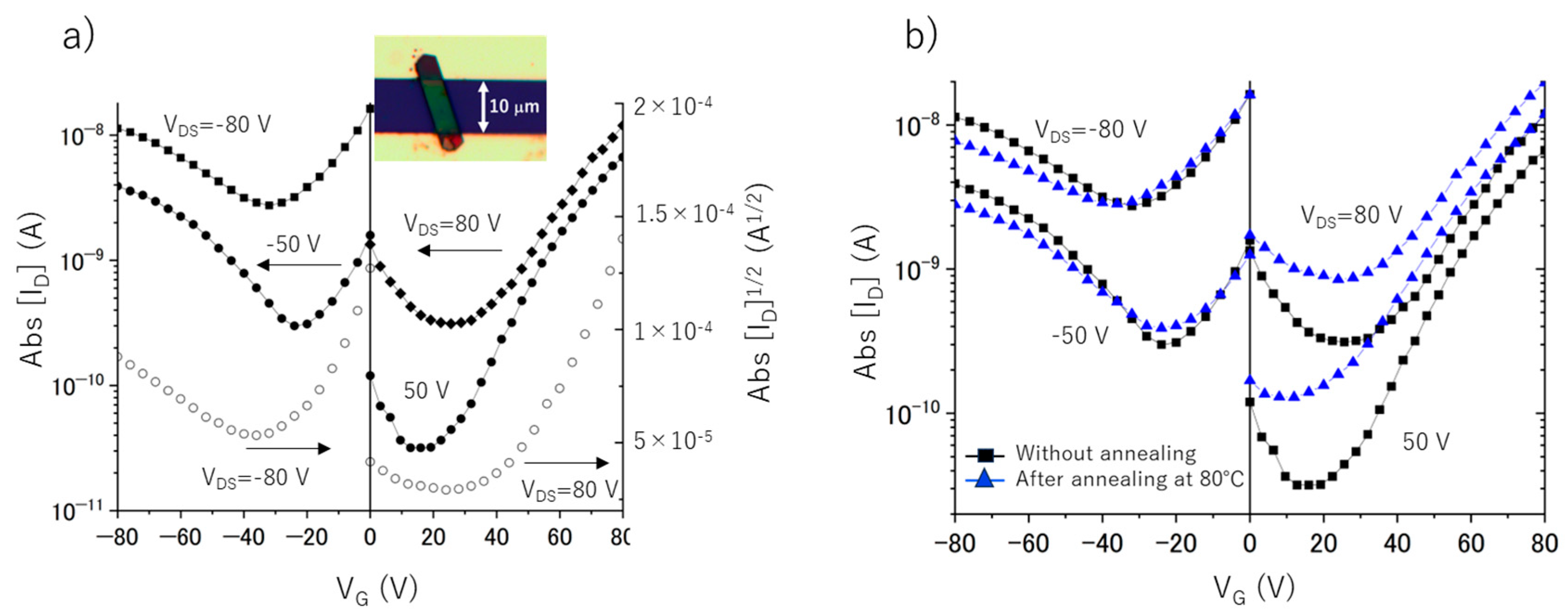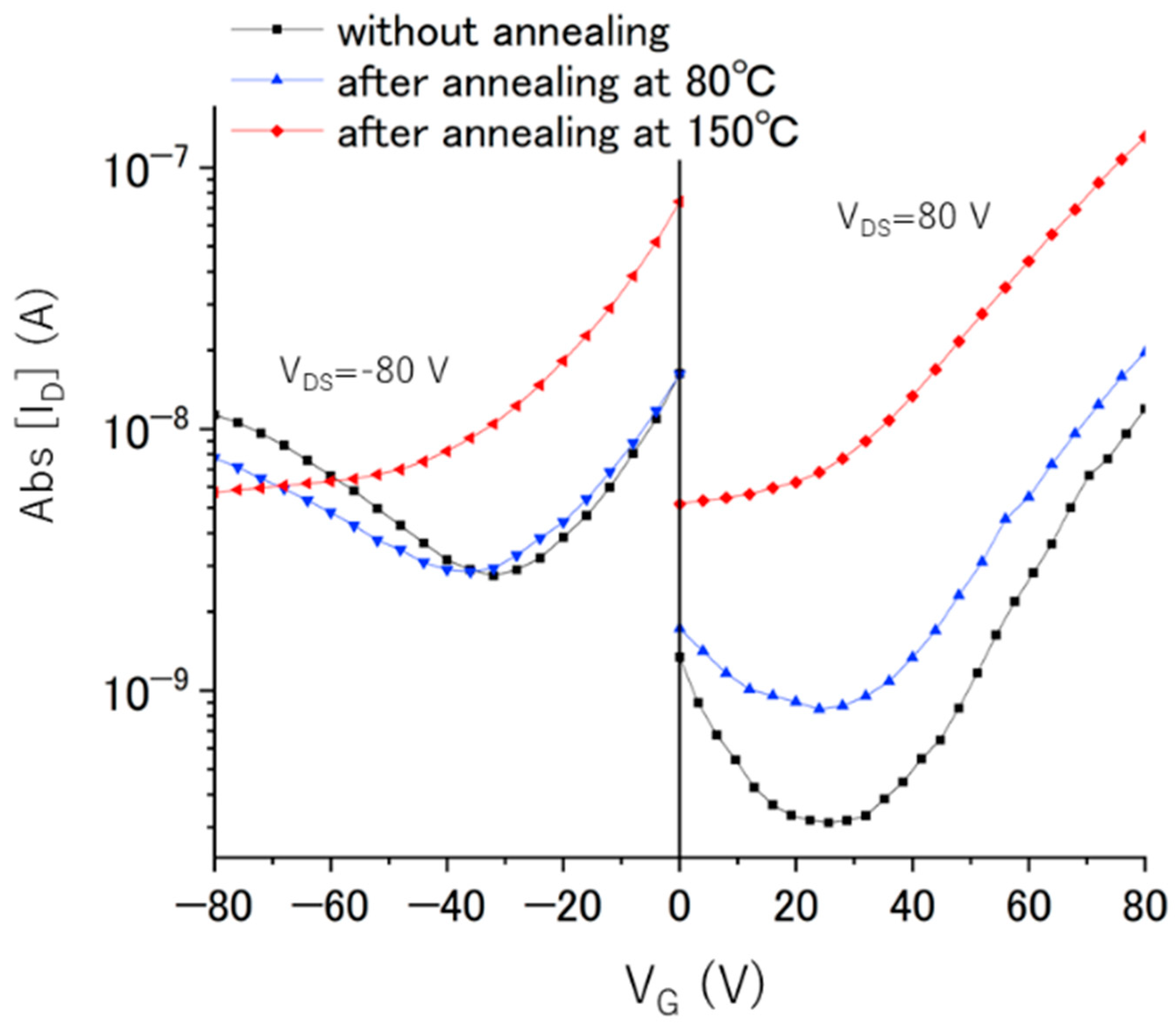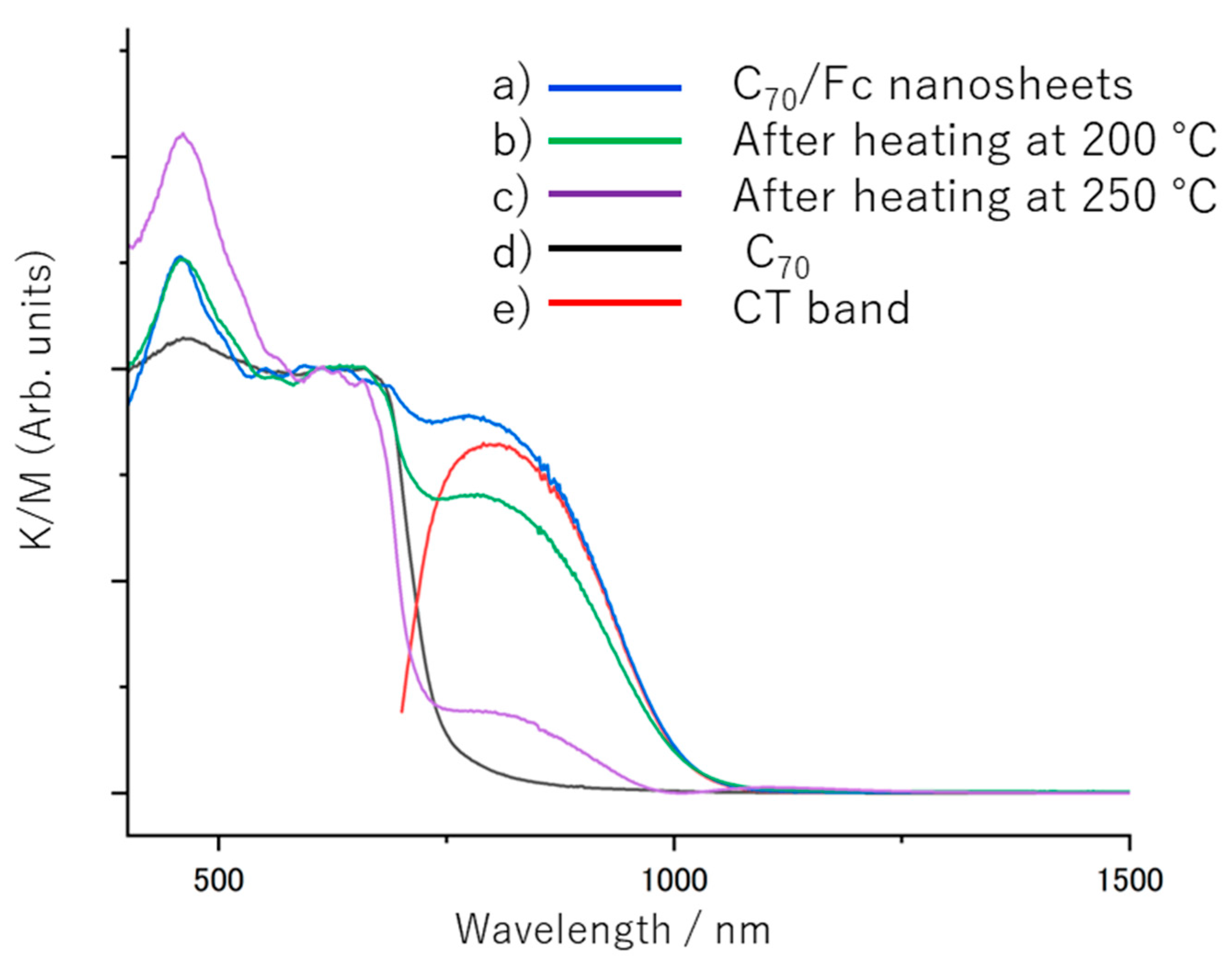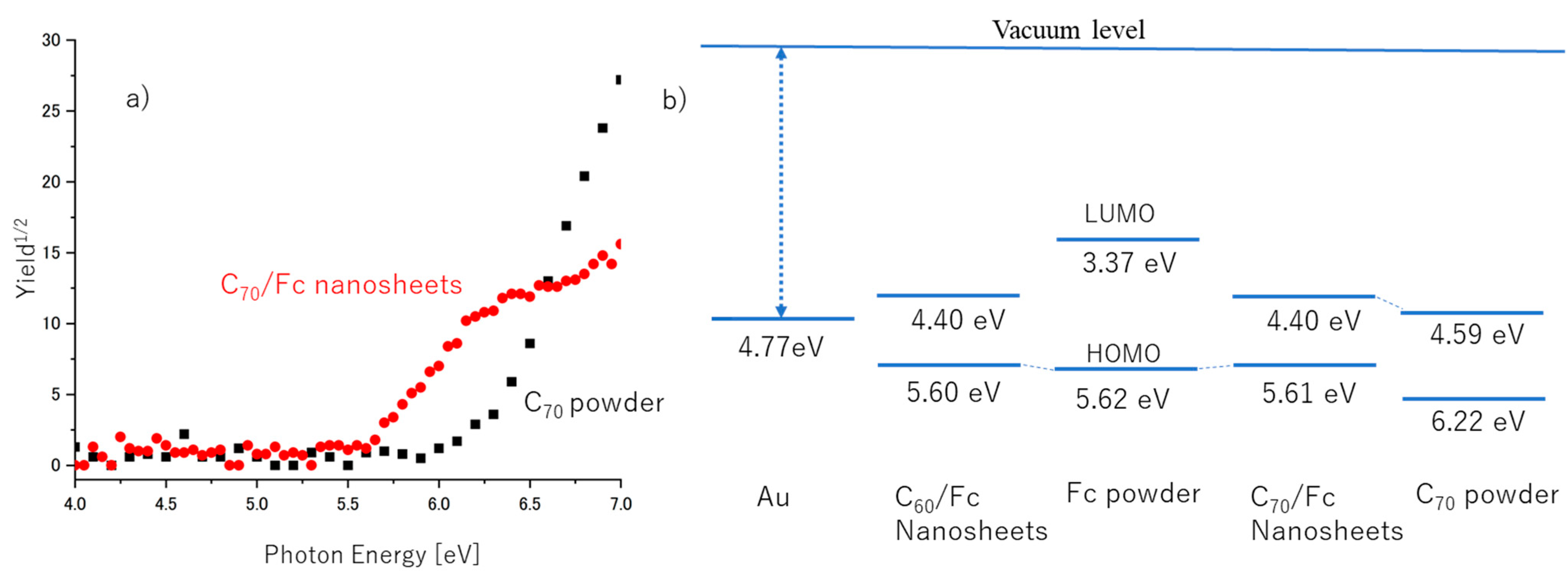Ambipolar to Unipolar Conversion in C70/Ferrocene Nanosheet Field-Effect Transistors
Abstract
:1. Introduction
2. Materials and Methods
3. Results and Discussion
4. Conclusions
Supplementary Materials
Author Contributions
Funding
Data Availability Statement
Acknowledgments
Conflicts of Interest
References
- Wakahara, T.; D’Angelo, P.; Miyazawa, K.; Nemoto, Y.; Ito, O.; Tanigaki, N.; Bradley, D.D.C.; Anthopoulos, T.D. Fullerene/cobalt porphyrin hybrid nanosheets with ambipolar charge transporting characteristics. J. Am. Chem. Soc. 2012, 134, 7204–7206. [Google Scholar] [CrossRef]
- Payne, S.; Andrusenko, I.; Papi, F.; Potticary, J.; Gemmi, M.; Hall, S.R. The crystal structure and electronic properties of three novel charge transfer co-crystals TCNQFn–triphenylene (n = 0, 2, 4). CrystEngComm 2023, 25, 828–834. [Google Scholar] [CrossRef]
- Garain, S.; Ansari, S.N.; Kongasseri, A.A.; Chandra Garain, B.; Pati, S.K.; George, S.J. Room temperature charge-transfer phosphorescence from organic donor–acceptor co-crystals. Chem. Sci. 2022, 13, 10011–10019. [Google Scholar] [CrossRef] [PubMed]
- Lu, C.; Li, N.; Jin, Y.; Sun, Y.; Wang, J. Physical mechanisms of intermolecular interactions and cross-space charge transfer in two-photon BDBT-TCNB co-crystals. Nanomaterials 2022, 12, 2757. [Google Scholar] [CrossRef] [PubMed]
- Bao, L.; Xu, T.; Guo, K.; Huang, W.; Lu, X. Supramolecular engineering of crystalline fullerene micro-/nano-architectures. Adv. Mater. 2022, 34, e2200189. [Google Scholar] [CrossRef]
- Li, Y.; Wang, P.; Duan, Z.; Zhang, T.; Tong, F. Controllable fabrication of organic cocrystals with interior hollow structure based on donor-acceptor charge transfer molecules. Crystals 2022, 12, 1781. [Google Scholar] [CrossRef]
- Liu, Y.; Li, A.; Xu, S.; Xu, W.; Liu, Y.; Tian, W.; Xu, B. Reversible luminescent switching in an organic cocrystal: Multi-stimuli-induced crystal-to-crystal phase transformation. Angew. Chem. Int. Ed. Engl. 2020, 59, 15098–15103. [Google Scholar] [CrossRef]
- Liu, Y.; Zeng, Q.; Zou, B.; Liu, Y.; Xu, B.; Tian, W. Piezochromic luminescence of donor-acceptor cocrystals: Distinct responses to anisotropic grinding and isotropic compression. Angew. Chem. Int. Ed. Engl. 2018, 57, 15670–15674. [Google Scholar] [CrossRef]
- Liu, H.-Y.; Li, Y.-C.; Wang, X.-D. Recent advances in organic donor–Acceptor Cocrystals: Design, synthetic approaches, and optical applications. CrystEngComm 2023, 25, 3126–3141. [Google Scholar] [CrossRef]
- Huang, Y.; Wang, Z.; Chen, Z.; Zhang, Q. Organic cocrystals: Beyond electrical conductivities and field-effect transistors (FETS). Angew. Chem. Int. Ed. Engl. 2019, 58, 9696–9711. [Google Scholar] [CrossRef]
- Sun, L.; Wang, Y.; Yang, F.; Zhang, X.; Hu, W. Cocrystal Engineering: A collaborative strategy toward Functional Materials. Adv. Mater. 2019, 31, 1902328. [Google Scholar] [CrossRef] [PubMed]
- Jèrome, D. Organic conductors: From charge density wave TTF−TCNQ to superconducting (TMTSF)2PF6. Chem. Rev. 2004, 104, 5565–5592. [Google Scholar] [CrossRef] [PubMed]
- Jiang, H.; Hu, W. The emergence of organic single-crystal electronics. Angew. Chem. Int. Ed. 2019, 59, 1408–1428. [Google Scholar] [CrossRef] [PubMed]
- Sun, L.; Zhu, W.; Zhang, X.; Li, L.; Dong, H.; Hu, W. Creating organic functional materials beyond chemical bond synthesis by organic cocrystal engineering. J. Am. Chem. Soc. 2021, 143, 19243–19256. [Google Scholar] [CrossRef]
- Hill, T.; Erasmus, R.M.; Levendis, D.C.; Lemmerer, A. Combining two distinctive intermolecular forces in designing ternary co-crystals and molecular salts of 1,3,5-trinitrobenzene, 9-anthracenecarboxylic acid and ten substituted pyridines. CrystEngComm 2019, 21, 5206–5210. [Google Scholar] [CrossRef]
- Yee, N.; Dadvand, A.; Hamzehpoor, E.; Titi, H.M.; Perepichka, D.F. Hydrogen bonding versus π-stacking in charge-transfer co-crystals. Cryst. Growth Des. 2021, 21, 2609–2613. [Google Scholar] [CrossRef]
- Mandal, A.; Choudhury, A.; Sau, S.; Iyer, P.K.; Mal, P. Exploring ambipolar semiconductor nature of binary and ternary charge-transfer cocrystals of triphenylene, pyrene, and TCNQ. J. Phys. Chem. C 2020, 124, 6544–6553. [Google Scholar] [CrossRef]
- Wang, D.; Kan, X.; Wu, C.; Gong, Y.; Guo, G.; Liang, T.; Wang, L.; Li, Z.; Zhao, Y. Charge transfer co-crystals based on donor–acceptor interactions for near-infrared photothermal conversion. Chem. Commun. 2020, 56, 5223–5226. [Google Scholar] [CrossRef]
- Fratini, S.; Nikolka, M.; Salleo, A.; Schweicher, G.; Sirringhaus, H. Charge transport in high-mobility conjugated polymers and molecular semiconductors. Nat. Mater. 2020, 19, 491–502. [Google Scholar] [CrossRef]
- Kumar, A.; Banerjee, K.; Ervasti, M.M.; Kezilebieke, S.; Dvorak, M.; Rinke, P.; Harju, A.; Liljeroth, P. Electronic characterization of a charge-transfer complex monolayer on graphene. ACS Nano 2021, 15, 9945–9954. [Google Scholar] [CrossRef]
- Chen, N.; Yu, P.; Guo, K.; Lu, X. Rubrene-directed structural transformation of fullerene (C60) microsheets to nanorod arrays with enhanced photoelectrochemical properties. Nanomaterials 2022, 12, 954. [Google Scholar] [CrossRef] [PubMed]
- Li, X.-L.; Zhang, G.; Zhang, X.; Zou, W.; Li, G.; Zhang, X.; Li, Y.; Zhang, L.; Wang, M.; Chen, B.; et al. Transparent charge transfer complex with high thermoelectric performance. Res. Sq. 2023. [Google Scholar] [CrossRef]
- Qin, Y.; Zhang, Q.; Chen, G. Organic borate doped carbon nanotube for enhancement of Thermoelectric Performance. Carbon 2021, 182, 742–748. [Google Scholar] [CrossRef]
- Ilie, M.; Dragoman, D.; Baibarac, M. Photoconductive behavior of the PPV/RGO composites: Insights of charge transfer process. Phys. Status Solidi B 2019, 256, 1800392. [Google Scholar] [CrossRef]
- Wang, J.-F.; Bian, R.-N.; Feng, T.; Xie, K.-F.; Wang, L.; Ding, Y.-J. A highly sensitive dual-channel chemical sensor for selective identification of B4O72−. Microchem. J. 2021, 160, 105676. [Google Scholar] [CrossRef]
- Liu, H.; Ye, Y.; Zhang, X.; Yang, T.; Wen, W.; Jiang, S. Ferroelectricity in organic materials: From materials characteristics to de novo design. J. Mater. Chem. C 2022, 10, 13676–13689. [Google Scholar] [CrossRef]
- Wang, C.; Qi, D.; Lu, G.; Wang, H.; Chen, Y.; Jiang, J. High mobility at the interface of the cocrystallized sandwich-type tetrapyrrole metal compound and fullerene layers. Inorg. Chem. Front. 2019, 6, 3345–3349. [Google Scholar] [CrossRef]
- Luo, L.; Huang, W.; Ju, Z.; Mu, Z.; Wang, W.; Zhou, Y.; Zhang, J.; Huang, W. Charge-transfer pentacene/benzothiadiazole derivative cocrystal for UV-to-nir large range responsive phototransistors. Org. Electron. 2022, 100, 106363. [Google Scholar] [CrossRef]
- Zhang, J.; Jin, J.; Xu, H.; Zhang, Q.; Huang, W. Recent progress on organic donor–acceptor complexes as active elements in organic field-effect transistors. J. Mater. Chem. C 2018, 6, 3485–3498. [Google Scholar] [CrossRef]
- Jiang, M.; Zhen, C.; Li, S.; Zhang, X.; Hu, W. Organic cocrystals: Recent advances and perspectives for electronic and Magnetic Applications. Front. Chem. 2021, 9, 764628. [Google Scholar] [CrossRef]
- Cuesta, V.; Vartanian, M.; Kumar Singh, M.; Singhal, R.; de la Cruz, P.; Sharma, G.D.; Langa, F. Ambipolar behavior of a Cu(II)–porphyrin derivative in ternary organic solar cells. Sol. RRL 2023, 7, 2201046. [Google Scholar] [CrossRef]
- Sanada, R.; Yoo, D.; Sato, R.; Iijima, K.; Kawamoto, T.; Mori, T. Ambipolar transistor properties of charge-transfer complexes containing perylene and Dicyanoquinonediimines. J. Phys. Chem. C 2019, 123, 12088–12095. [Google Scholar] [CrossRef]
- Wakahara, T.; Sathish, M.; Miyazawa, K.; Sasaki, T. Organic-metal-doped fullerene nanowhiskers. Nano 2008, 03, 351–354. [Google Scholar] [CrossRef]
- Mahdaoui, D.; Hirata, C.; Omri, N.; Wakahara, T.; Abderrabba, M.; Miyazawa, K. Optimization of the liquid–liquid interfacial precipitation method for the synthesis of C60 nanotubes. Bull. Mater. Sci. 2018, 41, 165. [Google Scholar] [CrossRef]
- Wakahara, T.; Sathish, M.; Miyazawa, K.; Hu, C.; Tateyama, Y.; Nemoto, Y.; Sasaki, T.; Ito, O. Preparation and optical properties of fullerene/ferrocene hybrid hexagonal nanosheets and large-scale production of fullerene hexagonal nanosheets. J. Am. Chem. Soc. 2009, 131, 9940–9944. [Google Scholar] [CrossRef]
- Wakahara, T.; Nagaoka, K.; Nakagawa, A.; Hirata, C.; Matsushita, Y.; Miyazawa, K.; Ito, O.; Wada, Y.; Takagi, M.; Ishimoto, T.; et al. One-dimensional fullerene/porphyrin cocrystals: Near-infrared light sensing through component interactions. ACS Appl. Mater. Interfaces 2020, 12, 2878–2883. [Google Scholar] [CrossRef]
- Takeya, H.; Kato, R.; Wakahara, T.; Miyazawa, K.; Yamaguchi, T.; Ozaki, T.; Okazaki, H.; Takano, Y. Preparation and superconductivity of potassium-doped fullerene nanowhiskers. Mater. Res. Bull. 2013, 48, 343–345. [Google Scholar] [CrossRef]
- Wakahara, T.; Nagaoka, K.; Hirata, C.; Miyazawa, K.; Fujii, K.; Matsushita, Y.; Ito, O.; Takagi, M.; Shimazaki, T.; Tachikawa, M.; et al. Fullerene C70/porphyrin hybrid nanoarchitectures: Single-cocrystal nanoribbons with ambipolar charge transport properties. RSC Adv. 2022, 12, 19548–19553. [Google Scholar] [CrossRef]
- Mahdaoui, D.; Hirata, C.; Nagaoka, K.; Miyazawa, K.; Fujii, K.; Ando, T.; Abderrabba, M.; Ito, O.; Takagi, M.; Ishimoto, T.; et al. Ambipolar to unipolar irreversible switching in nanosheet transistors: The role of ferrocene in fullerene/ferrocene nanosheets. J. Mater. Chem. C 2022, 10, 3770–3774. [Google Scholar] [CrossRef]
- Osonoe, K.; Kano, R.; Miyazawa, K.; Tachibana, M. Synthesis of C70 two-dimensional nanosheets by liquid–liquid interfacial precipitation method. J. Cryst. Growth 2014, 401, 458–461. [Google Scholar] [CrossRef]
- Rekab, W.; Stoeckel, M.A.; El Gemayel, M.; Gobbi, M.; Orgiu, E.; Samorì, P. High-performance phototransistors based on PDIF-CN2 Solution-processed single fiber and Multifiber Assembly. ACS Appl. Mater. Interfaces 2016, 8, 9829–9838. [Google Scholar] [CrossRef] [PubMed]
- Goudappagouda, G.; Gedda, M.; Kulkarni, G.U.; Babu, S.S. One-dimensional porphyrin–fullerene (C60) assemblies: Role of central metal ion in enhancing ambipolar mobility. Chemistry 2018, 24, 7695–7701. [Google Scholar] [CrossRef] [PubMed]
- Zhang, J.; Tan, J.; Ma, Z.; Xu, W.; Zhao, G.; Geng, H.; Di, C.; Hu, W.; Shuai, Z.; Singh, K.; et al. Fullerene/sulfur-bridged annulene cocrystals: Two-dimensional segregated heterojunctions with ambipolar transport properties and photoresponsivity. J. Am. Chem. Soc. 2013, 135, 558–561. [Google Scholar] [CrossRef] [PubMed]
- Liu, Z.; Ju, Z.; Ma, S.; Li, W.; Chen, J.; Yang, B.; Zhang, J. Organic charge-transfer complex based microstructure interfaces for solution-processable organic thin-film transistors toward Multifunctional Sensing. Adv. Electron. Mater. 2023, 9, 2300205. [Google Scholar] [CrossRef]
- Mahdaoui, D.; Hirata, C.; Nagaoka, K.; Miyazawa, K.; Fujii, K.; Ando, T.; Matsushita, Y.; Abderrabba, M.; Ito, O.; Tsukagoshi, K.; et al. Nanoarchitectonics of C70 hexagonal nanosheets: Synthesis and charge transport properties. Diam. Relat. Mater. 2022, 128, 109217. [Google Scholar] [CrossRef]
- Wang, S.; Hung, N.T.; Tian, H.; Islam, M.S.; Saito, R. Switching behavior of a heterostructure based on periodically doped graphene nanoribbon. Phys. Rev. Appl. 2021, 16, 024030. [Google Scholar] [CrossRef]
- Mitake, Y.; Gomita, A.; Yamamoto, R.; Watanabe, M.; Suzuki, R.; Aoki, N.; Tanimura, M.; Hirai, T.; Tachibana, M. Solvated C70 single crystals for Organic Field Effect Transistors. Chem. Phys. Lett. 2022, 807, 140094. [Google Scholar] [CrossRef]
- Doi, T.; Koyama, K.; Chiba, Y.; Ueno, M.; Chen, S.-R.; Aoki, N.; Bird, J.P.; Ochiai, Y. Electron Transport Properties in Photo and Supersonic Wave Irradiated C60 Fullerene Nano-Whisker Field-Effect Transistors. Jpn. J. Appl. Phys. 2010, 49, 04DN12. [Google Scholar] [CrossRef]
- Dai, X.; Meng, Q.; Zhang, F.; Zou, Y.; Di, C.; Zhu, D. Electronic Structure Engineering in organic thermoelectric materials. J. Energy Chem. 2021, 62, 204–219. [Google Scholar] [CrossRef]
- Li, X.; Huang, X.; Han, Y.; Chen, E.; Guo, P.; Zhang, W.; An, M.; Pan, Z.; Xu, Q.; Guo, X.; et al. High-performance γ-MnO2 dual-core, pair-hole fiber for ultrafast photonics. Ultrafast Sci. 2023, 3, 0006. [Google Scholar] [CrossRef]
- Guan, M.; Chen, D.; Hu, S.; Zhao, H.; You, P.; Meng, S. Theoretical insights into ultrafast dynamics in Quantum Materials. Ultrafast Sci. 2022, 2022, 9767251. [Google Scholar] [CrossRef]
- Zhang, Z.; Zhang, J.; Chen, Y.; Xia, T.; Wang, L.; Han, B.; He, F.; Sheng, Z.; Zhang, J. Bessel terahertz pulses from superluminal laser plasma filaments. Ultrafast Sci. 2022, 2022, 9870325. [Google Scholar] [CrossRef]
- Liu, X.; Yao, X.; Cui, Y. Real-time observation of the buildup of soliton molecules. Phys. Rev. Lett. 2018, 121, 023905. [Google Scholar] [CrossRef]
- Liu, X.; Pang, M. Revealing the buildup dynamics of Harmonic Mode-locking states in ultrafast Lasers. Laser Photonics Rev. 2019, 13, 1800333. [Google Scholar] [CrossRef]
- Liu, X.; Popa, D.; Akhmediev, N. Revealing the transition dynamics from Q switching to mode locking in a soliton laser. Phys. Rev. Lett. 2019, 123, 093901. [Google Scholar] [CrossRef]
- Li, X.; Xu, W.; Wang, Y.; Zhang, X.; Hui, Z.; Zhang, H.; Wageh, S.; Al-Hartomy, O.A.; Al-Sehemi, A.G. Optical-intensity modulators with PBTE thermoelectric nanopowders for ultrafast photonics. Appl. Mater. Today 2022, 28, 101546. [Google Scholar] [CrossRef]
- Li, X.; An, M.; Li, G.; Han, Y.; Guo, P.; Chen, E.; Hu, J.; Song, Z.; Lu, H.; Lu, J. Mof-derived porous dodecahedron rGO-Co3O4 for robust pulse generation. Adv. Mater. Interfaces 2022, 9, 2101933. [Google Scholar] [CrossRef]
- Zhang, C.; Liu, J.; Gao, Y.; Li, X.; Lu, H.; Wang, Y.; Feng, J.; Lu, J.; Ma, K.; Chen, X. Porous nickel oxide micron polyhedral particles for high-performance ultrafast photonics. Opt. Laser Technol. 2022, 146, 107546. [Google Scholar] [CrossRef]
- Zhao, Y.; Wang, W.; Li, X.; Lu, H.; Shi, Z.; Wang, Y.; Zhang, C.; Hu, J.; Shan, G. Functional porous MOF-derived cuo octahedra for harmonic Soliton Molecule Pulses generation. ACS Photonics 2020, 7, 2440–2447. [Google Scholar] [CrossRef]
- Zhang, C.; Li, X.; Chen, E.; Liu, H.; Shum, P.P.; Chen, X. Hydrazone Organics with third-order nonlinear optical effect for femtosecond pulse generation and control in the L-band. Opt. Laser Technol. 2022, 151, 108016. [Google Scholar] [CrossRef]
- Li, X.; Feng, J.; Mao, W.; Yin, F.; Jiang, J. Emerging uniform Cu2O nanocubes for 251st harmonic ultrashort pulse generation. J. Mater. Chem. C 2020, 8, 14386–14392. [Google Scholar] [CrossRef]




Disclaimer/Publisher’s Note: The statements, opinions and data contained in all publications are solely those of the individual author(s) and contributor(s) and not of MDPI and/or the editor(s). MDPI and/or the editor(s) disclaim responsibility for any injury to people or property resulting from any ideas, methods, instructions or products referred to in the content. |
© 2023 by the authors. Licensee MDPI, Basel, Switzerland. This article is an open access article distributed under the terms and conditions of the Creative Commons Attribution (CC BY) license (https://creativecommons.org/licenses/by/4.0/).
Share and Cite
Mahdaoui, D.; Hirata, C.; Nagaoka, K.; Miyazawa, K.; Fujii, K.; Ando, T.; Abderrabba, M.; Ito, O.; Yagyu, S.; Liu, Y.; et al. Ambipolar to Unipolar Conversion in C70/Ferrocene Nanosheet Field-Effect Transistors. Nanomaterials 2023, 13, 2469. https://doi.org/10.3390/nano13172469
Mahdaoui D, Hirata C, Nagaoka K, Miyazawa K, Fujii K, Ando T, Abderrabba M, Ito O, Yagyu S, Liu Y, et al. Ambipolar to Unipolar Conversion in C70/Ferrocene Nanosheet Field-Effect Transistors. Nanomaterials. 2023; 13(17):2469. https://doi.org/10.3390/nano13172469
Chicago/Turabian StyleMahdaoui, Dorra, Chika Hirata, Kahori Nagaoka, Kun’ichi Miyazawa, Kazuko Fujii, Toshihiro Ando, Manef Abderrabba, Osamu Ito, Shinjiro Yagyu, Yubin Liu, and et al. 2023. "Ambipolar to Unipolar Conversion in C70/Ferrocene Nanosheet Field-Effect Transistors" Nanomaterials 13, no. 17: 2469. https://doi.org/10.3390/nano13172469
APA StyleMahdaoui, D., Hirata, C., Nagaoka, K., Miyazawa, K., Fujii, K., Ando, T., Abderrabba, M., Ito, O., Yagyu, S., Liu, Y., Nakajima, Y., Tsukagoshi, K., & Wakahara, T. (2023). Ambipolar to Unipolar Conversion in C70/Ferrocene Nanosheet Field-Effect Transistors. Nanomaterials, 13(17), 2469. https://doi.org/10.3390/nano13172469





